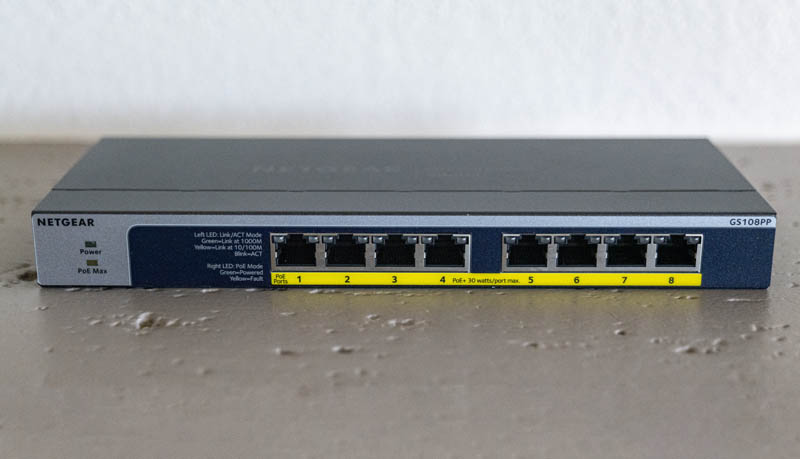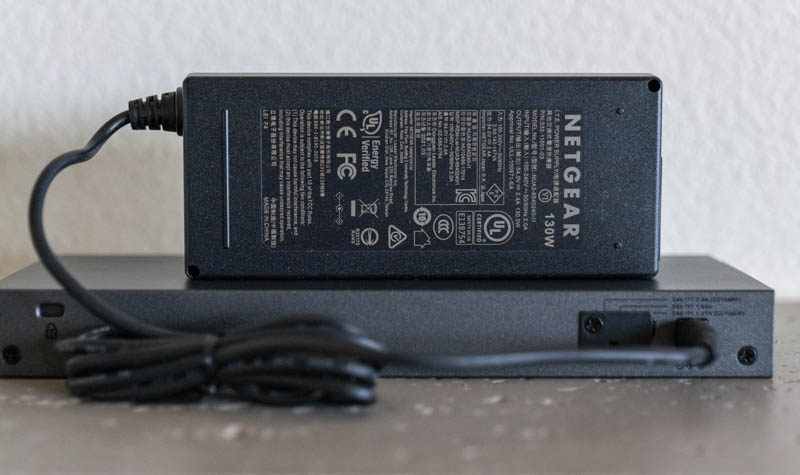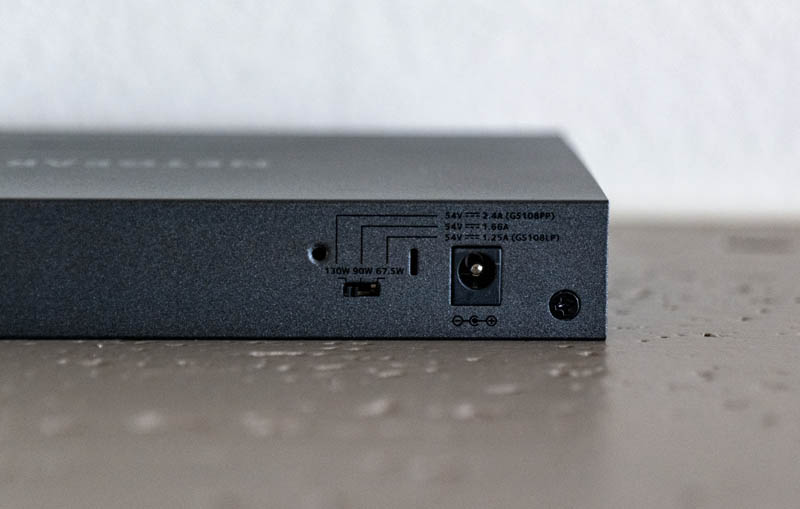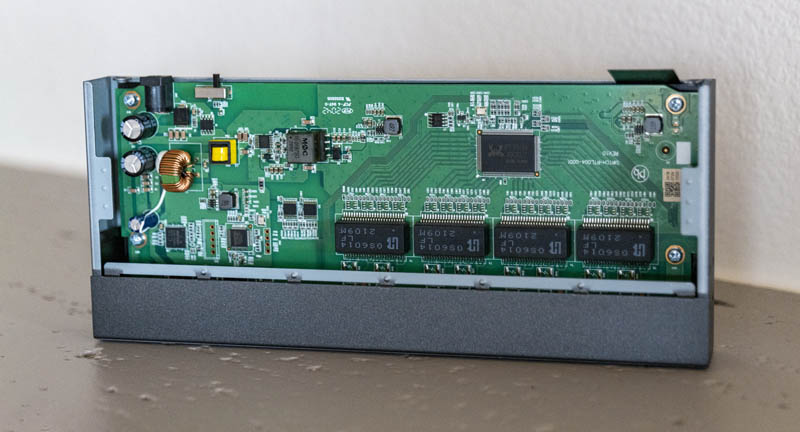A few months ago we looked at the Netgear GC108PP in a review. That is a 126W PoE+ solution that was managed using Netgear Insight. Many of our readers commented that they would prefer to see a review of an unmanaged option that does not use Insight. Today we have that unit in the Netgear GS108PP 8-Port PoE+ switch we are reviewing. While many of our readers want management features on all switches, others simply want PoE/ PoE+ to go to devices like cameras and then will use the uplink port to tag traffic and other features. Unmanaged switches are simpler and so that can make them, in some ways, more reliable.
Netgear GS108PP Hardware Overview
The hardware of the switch is very simple. We have basic Power and PoE Max status LEDs. There are eight 1GbE ports on the front of the switch. Unlike some lower-end solutions, each port is capable of providing power. This is a lower-end unit however since it is 1GbE only and does not have 2.5GbE or 10GbE for higher-performance APs and systems.

Power is provided with up to PoE+ 30W maximum per port. If you want to learn more about the key differences of PoE vs PoE+ vs PoE++ switches we have a STH guide. We get an external 130W power supply for the unit that is able to provide up to 123W based on the switch power (<=7W) minus the power supply power.

Something that is important here is that the power supply cannot power all eight ports at 30W since 8x 30W = 240W. There are, however, savings. For example, most likely the uplink port is going into another switch that is not being powered using PoE so that is some savings. Although, it would be interesting to power a MikroTik CRS305-1G-4S+IN, MikroTik CRS326-24G-2S+IN, or another switch that can be powered via PoE-in that is also an uplink to provide redundant power.
The rear of the unit is fairly simple except for a lock port and a power input port. There is, however, a door that is screwed shut.

Unscrewing that door leads us to a switch. Netgear seems to make the same switch and then bundle with a different 54V PSU depending on how it markets the switch. One can imagine that if word got out about this due to the door not being present, users may realize there can be an option to purchase the lower power GS108LP plus a 90W or 130W PSU at a lower cost. Of course, it is somewhat a bummer that this switch even needs to be present since the unit is capable of 130W input.

Inside the switch, we see a relatively simple PCB. There is actually a bit less PoE gear than we would have expected seeing other switches.

With the unit, we get a number of mounting options including desktop, wall, and even rackmount ears for rack mounting the switch.

One item we will note is that these rack ears are not a full 1U in height. As a result, air (potentially cables) can pass around these rack ears which is not ideal for containment.
Overall, this is a good package for what it is.
Next we are going to take a look at performance, power consumption, and noise.





Aren’t 8 port 1GbE POE switches a dime a dozen now a days? A review of the 2.5GbE or the 10GbE would be more relevant.
It’s PoE+ tho
I understand why low-end switches do not have Uplink ports…cost and-or chipset. Vendors in the low-end are optimizing the product for the lowest cost per unit. They save money by not having that dedicated uplink port and a more expensive chipset needed to support it.
The same explanation sort of applies to not having a power supply that can provide full POE power to all ports…per unit cost savings. Leave the power management issues to the customer instead of overbuilding the product.
Perhaps The Rolling Stones got it right:
“You can’t always get what you want…but sometimes you get what you need.”
As for Netgear’s Insight product…call it what it is…a marketing angle to boost company revenue by hooking into the hype of “being in the cloud” (some people can be “sold” on that hype).
I have some Netgear managed switches that required an Insight account in order to activate their full feature set (or you can do that completely offline, if you are not in a rush for the keycode), but all of my Netgear switches are BLOCKED from communicating with anything on the Internet (any needed services are in-house) because of unexplained Internet access activities by devices that were activated through Insight. And NO, I never got any decent explanation out of Netgear for that nefarious behavior. So much for truth and transparency.
I don’t know about the quality of their switches, but Unifi has (almost) released an 8×2.5GBE + 2x10GBE (spf): https://eu.store.ui.com/collections/unifi-network-routing-switching/products/unifi-enterprise-8-poe-beta
I am interested as this is what I have been waiting for. Though I’m not too fond of the requirement of a controller for the APs to work (it has to run 24/7), I hope it’s not the same with their switches.
re: …external…power supply… …rackmount ears…
This provoked some cognitive dissonance, leading to some web searching. Perhaps STH could do an entertaining general article on the topic of wallwarts and lumpy cables in racks.
I would have expected that most rack room temple dogma would include: no power bricks in the racks, for a long list of reasons.
But then I stumbled across incipient products in the ONErack Spider line, which at least drives off the bricks. Seriously? People are willing to polarity-check & chop the nearly-bespoke DC cables at the bricks, then attached TVOne’s DC connectors at their 0U DC PSU?
I was doing accessory product management 20 years ago, including rackmount kits, and rack power cords. It was strictly C13/C14, C15/C16 & C19/C20 AC. Exactly none of the powered devices we sold for rack use were powered by AC adaptors.